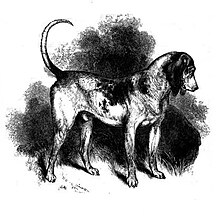Southern Hound
| Southern Hound | |
|---|---|
 Southern Hound (illustration from The Dog 1852) | |
| Origin | Britain |
| Breed status | Extinct. Not recognized as a breed by any major kennel club. |
| Dog (domestic dog) | |
The Southern Hound was a breed of dog that existed in Britain probably until sometime in the 19th century. The exact date of its extinction is not known; it is likely that it was gradually interbred with other breeds until the the genuine Southern Hound bloodline ceased to exist.
The origins of the Southern Hound are equally unclear. Most writers suggest that it is derived from the Talbot Hound that was brought to Britain in the 11th century after the Norman Conquest. The Talbot was a predominantly white, slow, deep-throated, scent hound derived from the St. Hubert Hound which had been developed in the 8th century. At some point the English Talbots were crossed with Greyhounds to give them an extra turn of speed.[1] In The Dog published in 1852, William Youatt states that the Southern Hound may have existed in Britain since ancient times rather than being brought from France by the Normans.[2]
The Southern Hound was a tall, heavy dog with a square head, and long ears. It had a deep chest, a long bony body and a deep melodious voice. It was a slow dog, but with excellent scenting abilities and was employed to follow the trail of the quarry during a hunt. Because of its lack of speed and deliberate nature, it was considered best used for hunting game such as hare or deer, which would eventually be exhausted by its relentless pursuit but, unlike a fox or rabbit, could not escape to the safety of a den or burrow.[3]
It was still common south of the River Trent in the 1700s. Further north the North Country Beagle or Northern Hound was favoured. This was a faster dog but probably lacked the delicate nose of the Southern Hound. In his The Dog, in Health and Disease in 1859, "Stonehenge" (the pen name of John Henry Walsh, editor of The Field) says the two breeds could be differentiated by the large dewlap present in the Southern Hound, but the illustration of the Southern Hound in the same book lacks this detail. How far the Talbot, Northern Hound and Southern Hound were intermixed is impossible to ascertain: authors writing in the mid-19th century were already having difficulty distinguishing between the three breeds.[3]
The Southern Hound seems to have fallen out of favour during the 18th century as the fashion for shorter hunts led to the development of the faster Foxhound. Youatt wrote that there were still packs in use in Devon in the 19th century and that the Southern Hound was sometimes used in conjunction with Foxhound packs to help pick up the cold trail when the pack lost the scent.[2] Some were employed in Wales on polecat hunts (that could last several days), and they appear to have been used to hunt otter before being employed as breeding stock for the development of the Otterhound.[4]
Many of the modern hound breeds are believed to have Southern Hound blood: Beagles, Harriers, Foxhounds, Coonhounds and Bloodhounds among others.
Notes
References
- Leighton, Robert (2004). Dogs and All About Them. Kessinger Publishing. p. 292. ISBN 1419116363.
{{cite book}}: Unknown parameter|origdate=ignored (|orig-date=suggested) (help) - "Stonehenge", (J. H. Walsh) (1859). The Dog, in Health and Disease. London: Longman, Green, Longman and Roberts.
- Smith, Steve (2002). The Encyclopedia of North American Sporting Dogs. Willow Creek Press. p. 256. ISBN 1572235012.
- Youatt, William (1852). The Dog. Blanchard and Lea. p. 403.
